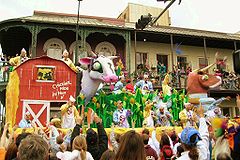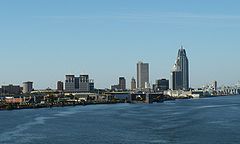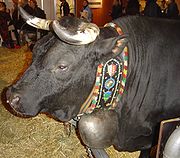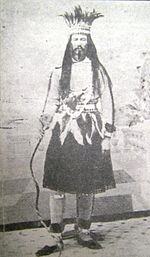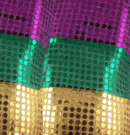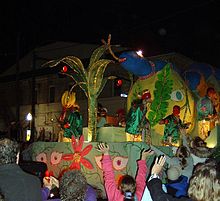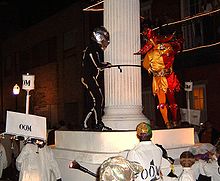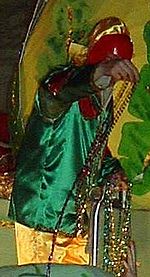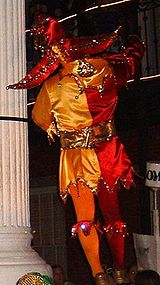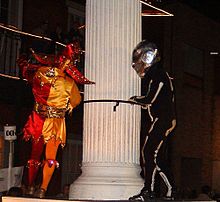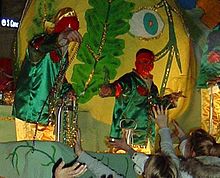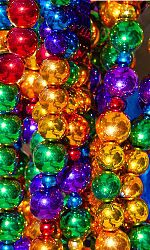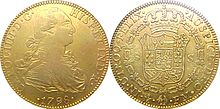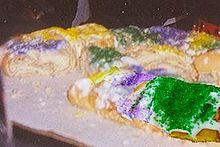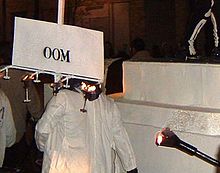- Mardi Gras in Mobile
-
Mardi Gras in Mobile, Alabama[pronounce] is the oldest annual Carnival celebration in America, having begun in 1703,[1][2][3] over 15 years before New Orleans was founded (1718).[3] From Mobile being the first capital of French Louisiana (1702), the festival began as a French Catholic tradition, celebrating until the start of Lent on Ash Wednesday, until midnight on Mardi Gras day (French for "Fat Tuesday" or Shrove Tuesday). However, Mardi Gras in Mobile now has evolved into a mainstream multi-week celebration across the spectrum of cultures in Mobile, becoming school holidays[4] for the final Monday and Tuesday (some include Wednesday),[5] regardless of religious affiliation. Although Mobile has traditions of exclusive societies, with formal masked balls and elegant costumes, the celebration has evolved over the past three centuries to become typified by public parades where members of societies, often masked, on floats or horseback [6] [7] toss gifts to the general public, as throws, including plastic beads, doubloon coins,[6] decorated plastic cups, candy,[6] wrapped cakes/snacks,[6] stuffed animals,[7] and small toys,[7] footballs, frisbees, or whistles.[7]
Contents
The masked balls or dances, where non-masked men wear white tie and tails (full dress or costume de rigueur) and the women wear full length evening gowns, are oriented to adults, with some mystic societies treating the balls as an extension of the debutante season of their exclusive social circles. Various nightclubs and local bars offer their own particular events.
Beyond the public parades, Mardi Gras in Mobile involves many various mystic societies, some having begun in 1704, or ending with the Civil War, while new societies were formed every century. Some mystic societies are never seen in public parades, but rather hold invitation-only events for their secret members, with private balls beginning in November, each year.
Overview of events

The Mobile Mardi Gras season starts in November[8][9][10] with exclusive parties held by some secret mystic societies, then New Year's Eve balls. It has become closely entwined with the social debutante season for certain families. Other mystic societies begin their events at Twelfth Night (January 6), with parades, balls (some of them masquerade balls), and king cake parties.
During the last two weeks before Mardi Gras, at least one major parade takes place each day in the city.[9] The largest and most elaborate parades take place the last few days of the season. In the final week of Mardi Gras, many events large and small occur throughout Mobile and the surrounding communities (see event schedule[6]).
The parades in Mobile are organized mainly by Carnival krewes or orders. Krewe float riders toss throws to the crowds. The most common throws are strings of colorful plastic beads,[6] doubloons (aluminium or wooden dollar-sized coins usually impressed with a krewe logo),[6] wrapped candy/snacks/MoonPies,[6][7] decorated plastic throw cups, stuffed animals,[7] and other small inexpensive toys.[7] Major krewes follow the same parade schedule and route each year.
To Mobilians, "Mardi Gras" refers to the entire festival season, also known as Carnival. [11] Local schools have multiple "Mardi Gras Holidays" [4](which can include Ash Wednesday),[5] with the final Tuesday called "Fat Tuesday" or "Mardi Gras Day".[6] Mobile's culture has become diverse, and the Mardi Gras season has been extended. The area's traditions draw from all its history, including French, Spanish, British, African, Creole, American, and even Swedish influences.
History
A type of Mardi Gras festival was brought to Mobile by the founding French Catholic settlers of French Louisiana, as the celebration of Mardi Gras was part of preparation for Ash Wednesday and the beginning of Lent. The first record of the holiday being marked in America is on March 3, 1699,[12] at a camp site along the Mississippi River delta. After the construction of Fort Louis de la Mobile (1700–1702), the settlers celebrated Mardi Gras in Mobile in 1703, beginning an annual tradition, only occasionally canceled because of war.[3][6]
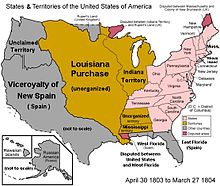 Mobile was the capital of La Louisiane in 1702, but became British in 1763. Mobile later became part of Spanish West Florida (1780–1812). The Carnivale (Carneval) began on Twelfth Night (January 6) with torch-lit processions[2].
Mobile was the capital of La Louisiane in 1702, but became British in 1763. Mobile later became part of Spanish West Florida (1780–1812). The Carnivale (Carneval) began on Twelfth Night (January 6) with torch-lit processions[2].
Mardi Gras has evolved over centuries in the Mobile area, combining tradition and culture with new ideas. French Mardi Gras arrived in North America with the founding French settlers, the Le Moyne brothers,[3] Pierre Le Moyne d'Iberville and Jean-Baptiste Le Moyne de Bienville: in the late 17th century, King Louis XIV sent the pair to defend France's claim on the territory of La Louisiane, which included what are now the U.S. states of Alabama and Louisiana.[13]
The two explorers, coming through Dauphin Island (Alabama), navigated the mouth of the Mississippi River (charted by Cavelier de La Salle, 1682), sailed upstream, and on March 3, 1699, celebrated, naming the spot Pointe du Mardi Gras (French: "Mardi Gras Point")[12] 60 miles downriver from the wilderness that would become New Orleans 20 years later.[3] Meanwhile, between 1700–1702, the 21-year-old Bienville founded the settlement of Mobile (Alabama), as the first capital of French Louisiana, [14] and in 1703, the American Mardi Gras tradition began with French annual celebrations in Mobile.[2][3] [15][16] The feasting and revelry on Mardi Gras in Mobile was called Boeuf Gras (Fatted Ox).[6] The masked ball, Masque de la Mobile, began in 1704,[3] and the first known parade was in 1711,[3] when Mobile's "Boeuf Gras Society" ("fat beef society") paraded on Mardi Gras, with 16 men pushing a cart carrying a large papier-mâché cow's head.[2]
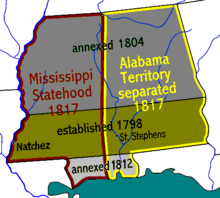 Mobile shifted to Mississippi Territory in 1812, Alabama Territory in 1817, and Alabama state in 1819
Mobile shifted to Mississippi Territory in 1812, Alabama Territory in 1817, and Alabama state in 1819
By 1720, Biloxi became the second capital of Louisiana, and also celebrated French customs.[3] Due to fear of tides and hurricanes, in 1723, the capital was moved to the inland port founded 1718[14] and called "Nouvelle-Orléans" (New Orleans).[3] That city also started a Mardi Gras celebration.
In 1763, Mobile came under British control. Its restrictions on free blacks and racial segregation caused many Creoles to leave Mobile and move west towards New Orleans. In 1780, Spain took control of the Mobile area in the aftermath of the American Revolution. The Carnival celebration incorporated the Spanish custom of torch-lit parades[2] on Twelfth Night (January 6, also known as Epiphany.) In 1813, Mobile became a United States city, included in the Mississippi Territory. In 1817 it was part of the Alabama Territory. In the Anglican and Episcopal traditions, the day before Ash Wednesday was celebrated as Shrove Tuesday, marked by consumption of rich foods before the fasting practices of Lent.
About 11 years after Alabama became a state (1819), a group of revelers, led by Michael Krafft, who was likely influenced by his Pennsylvania Swedish traditions of celebrating the New Year, stayed awake all New Year's Eve, started a dawn parade on January 1, 1831, making noise with cowbells, hoes, and rakes.[3] [17] The group became the first parading mystic society (or "krewe"), calling themselves the Cowbellion de Rakin Society, in a parody of French. They had annual parades each New Year's Eve.[2][3] Nearly 125 years after Mobile's first parade of 1711,[3] the new mystic society from Mobile, the Cowbellion de Rakin Society (1830), took their parade into New Orleans, circa 1835.[3] In 1838, people in New Orleans adopted the "European custom of celebrating the last day of the Carnival by a procession of masqued figures through the streets."[13]
In 1843, some men who had been refused membership by the Cowbellions, formed the Mobile "Strikers Independent Society" with their own New Year's parade. However, other men from Mobile formed the New Orleans Cowbellions in 1850,[3] and in 1857, that Cowbellion society, renamed the Mistick Krewe of Comus, held its first parade on Mardi Gras in New Orleans.[13] The Boeuf Gras Society (1711–1861) held their last procession on Shrove Tuesday in 1861, before the American Civil War, and then dissolved.[2][18]
In 1867, after the Civil War, Joe Cain revived the parades in Mobile on Mardi Gras,[1][3] riding in a decorated charcoal wagon, along with six fellow veterans.[2] That event is celebrated annually with Joe Cain Day (since 1966)[1] and a parade on the Sunday before Ash Wednesday. The event's founder, artist and historian Julian Lee "Judy" Rayford, portrayed the "Chief" and in 1970 handed the features to the third "Old Slac", fireman J. B. "Red" Foster. Foster prtrayed the "Chief" until passing the features in 1985 to historian, public relations professional and pastor, Bennett Wayne Dean Sr. Dean, as Old Slac IV "hisself", celebrated his 25th year under the feathers on Joe Cain Day in 2010.
War, economic, political, and weather conditions sometimes led to cancellation of some or all major parades, especially during the Civil War and World War II. The city has traditionally always observed some celebration of Mardi Gras.
Today, many mystic societies operate under a business structure; membership is basically open to anyone who pays dues to have a place on a parade float. In contrast, the traditional mystic societies were social clubs with secret membership lists. Divulging one's membership in a society can be grounds for dismissal. Some of the newer mystic societies actively recruit prospective members. Some of the older societies have restricted membership, with waiting lists numbering in the hundreds; others restrict members to alumni of particular schools, or other conventions.
The oldest parading society in Mobile is the Order of Myths, founded in 1867.[1] Its Emblem consists of Folly chasing Death around the broken pillar of life, a symbol of Mardi Gras in Mobile. Other notable mystic societies include the Knights of Revelry (with its Folly dancing on the rim of a huge champagne glass), Comic Cowboys, Infant Mystics, Mystics of Time, Crewe of Columbus, Mystic Stripers Society, Order of Inca and Conde Cavaliers. Ladies' societies include the Order of Polka Dots (OOP), oldest and largest of the Mobile ladies, and the Maids of Mirth (MOMs), their friendly mystic rivals who hit the streets just one day following the OOP in 1950. Other women's mystic societies who have made a name for themselves include the society with the grammatically incorrect name, Order of LaShe's (sic.), Order of Athena (which kicks off the parades on Mardi Gras Day) and Neptune's Daughters. Each of these societies have contributed something to the fabric of Mobile's Mardi Gras tradition.
Traditional colors
Meaning of Colors Justice (purple) Faith (green) Power (gold) The traditional colors of Mardi Gras in Mobile are purple and gold. Purple has been related to royal monarchies in Europe, and is the liturgical color used during Lent in Christianity. Many people in Mobile have incorporated a third color of green, perhaps from New Orleans' traditional colors of purple, green, and gold, from the Russian House of Romanov in 1872, when Grand Duke Alexis Romanoff Alexandrovitch, brother of the heir apparent to the throne of Russia, had accepted New Orlean's invitation to attend Mardi Gras, with festivities in his honor.[13]
After Hurricane Katrina
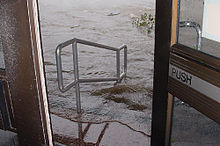 Mobile, Alabama: Downtown flood waters came several feet up the Federal Courthouse steps during Hurricane Katrina, 4 months before Mardi Gras 2006.
Mobile, Alabama: Downtown flood waters came several feet up the Federal Courthouse steps during Hurricane Katrina, 4 months before Mardi Gras 2006.
Like so much of the Gulf Coast, many parts of Mobile were flooded due to the intense storm surge caused by Hurricane Katrina on August 28–29, 2005.[19] Although some waterfront areas were submerged and battered by high waves over 16 ft (5 m), Downtown Mobile was flooded only several feet deep, including the downtown parade routes. Despite these difficulties, enough of the routes were cleared to continue Mardi Gras celebrations, and Mobile had the largest Mardi Gras in its history following the storm.[19][20] The following year, the 2007 Mardi Gras season in Mobile was attended by nearly 0.9 million people, [21] with police estimating the overall attendance at 878,000[21] and a crowd of 105,600 along the streets for the Fat Tuesday finale.[21]
Contemporary Mardi Gras
Each year, the Mardi Gras (or Carnival) season starts with three major events: the November parties of the International Carnival Ball and the Camellia Ball,[9] New Year's Eve and January 6, also known as "Twelfth Night" or the Feast of the Epiphany. In Mobile, the parade season generally starts three weekends before Mardi Gras Day with the Conde Cavaliers parade.
Starting two Fridays before Mardi Gras, there is usually at least one parade every night. The Wednesday before Mardi Gras is reserved as a "rain out" day in case one or more of the earlier parades are affected by weather.
The weekend before Mardi Gras
Multiple parades lead up to Mardi Gras day. On Sunday (before Fat Tuesday), Joe Cain Day celebrations are held. In recent years these have included a joggers run and the Joe Cain Procession, also known as the "People's Parade", as originally, joining the parade did not require membership in a mystic society. It is always led by Chief Slacabamorinico "hisself" personified today by only the fourth person in the city's long-Carnival history to wear the features of the "Chief". He is surrounded by the Mistresses of Joe Cain mourning in red and followed by Cain's Merry Widows wailing in black.
Lundi Gras
The Monday before Ash Wednesday is known as "Lundi Gras" ("Fat Monday"), after the French tradition of eating good foods this day as well as Tuesday, in preparation for dietary restrictions during Lent. In Mobile, Lundi Gras is traditionally a family day. Schools are closed both Lundi and Mardi Gras. At noon, the Mobile Carnival Association's Floral Parade is held, with area parochial and public schools providing floats and young riders. The Optimist Club hosts a family-oriented midway near Fort Conde, complete with carnival rides, food, games and activities. Lundi Gras is also a day for king cake parties and other family get-togethers in Mobile.
As a tradition, after other parades, the Infant Mystics society has held its parade annually after 6 p.m. on this Monday night in downtown Mobile.
Annual events are shown in the Lundi Gras event schedule of Mardi Gras 2009:
-
- 11:00 am Arrival of King Felix III (name of Mobile's carnival king) on Government St.
- 12:00 pm (Noon) Felix III Parade and Floral Parade
- 3:00 pm MLK Business and Civic Organization Parade (rolls on Route D)
- 3:30 pm MLK Monday Mystics Parade (rolls on Route D)
- 4:00 pm Northside Merchants Parade (rolls on Route D)
- 6:30 pm Infant Mystics Parade[23]
Mardi Gras Day
Celebrations begin early on Mardi Gras day. Downtown, the long parade organized by the Order of Athena rolls first, followed by the Comic Cowboys, founded in 1884. The evening ends with a spectacular night parade of illuminated floats decorated to a theme chosen by the Order of Myths. Each parade follows a defined route so that viewers can plan attendance along particular streets or balconies.
Some parades are long and circular so that viewers can walk to a second viewing spot and catch more throws, as the floats circle back. It allows more time to see performances as well.
The Fat Tuesday event schedule for Mardi Gras 2009 is as follows:
- Events on Tuesday, February 24, 2009:[23]
-
- FAT TUESDAY! (always the day before Ash Wednesday)
- 10:30 am Order of Athena Parade
- 12:30 pm Knights of Revelry Parade
- 1:00 pm King Felix III Parade
- 1:30 pm Comic Cowboys Parade
- 2:00 pm Mobile Area Mardi Gras Association (rolls on Route B)
- 6:30 pm Order of Myths Parade (rolls on Route C)
Numerous smaller parades and walking clubs also parade around the city.
The end of Mardi Gras
Promptly at the stroke of midnight at the end of Fat Tuesday, all festivities related to Mardi Gras cease, as it is the start of Lent. The city quickly cleans the streets for the next day. Local traditions frown on wearing Mardi Gras beads during Lent. Both Catholics and other Christians often observe Lenten rituals, such as giving up certain foods or taking on charitable obligations during the season of repentance.
Costumes and masks
On the days before Fat Tuesday (other than at parties), people who do not belong to a mystic society seldom wear costumes and masks publicly. Sometimes the general public may wear costumes or masks on Mardi Gras Day. Most people simply dress to be attractive, enjoying the open air and the chance to socialize with other people.
Mystic society members wear elaborate costumes that reflect the theme of their parade, ball or float. Costumes include custom-made hats or feather headdresses, though some societies do not require this. Most of the traditional krewes require riders to wear a mask that is sufficient to conceal the rider's identity. Excessive cutting of the mask or removing the mask at anytime during the parade is grounds for dismissal from some societies. Some mystic societies also require that members wear masks during the society's ball (typically held the same night of its parade).
Since 1957, the general public has been allowed to wear masks only on Mardi Gras day from 9am – 9pm, or if they are members of mystic societies.[1] The restriction related to problems with masked bandits and also associations with the damage done by the Ku Klux Klan. (See below: Legal restrictions.)
 Mardi Gras mask
Mardi Gras mask
Commercialization
There is virtually no commercial advertising during the Mobile parades, as it was prohibited by law in 1935.[3] The various floats in a parade have been designed as independent creations, although some mystic societies have entertained the idea of corporate sponsors.
Floats
The design, construction and decoration of Mardi Gras floats is a year-round business in Mobile. Several companies along the Gulf Coast do no other work than building floats. The larger floats in Mobile's parades are designed to hold about 15 or 16 adult men and their throws. City regulations stipulate length, width and height of floats, to ensure that the floats can safely navigate the narrow streets and tight turns of Downtown Mobile.
The floats are typically multi-level, with a lower level, an upper level, and one or two mezzanine stations (typically near the back of the float). The Float "captain" typically rides on the upper level, which lets him or her see everyone on the float. For floats in night-time parades, the structures are wired for lighting, and a portable generator is towed behind the float to provide power. Each float also contains some type of portable restroom facilities. Although from the street, a Mardi Gras float might look like a dainty, flimsy contraption, the reality is that they are quite sturdily built and are capable of withstanding a good rocking by the riders.
Some of Mobile's most famous floats include:
- Order of Myths Emblem: Folly chasing Death around the broken pillar of life.
- Knights of Revelry Emblem: Folly dancing in the goblet of life.
- Infant Mystics Emblem: A black cat atop a cotton bale, the foundation of Mobile's antebellum wealth
- Mystics of Time's Vernadean, Verna & Dean: Giant, rolling fire and smoke-breathing dragon floats
- Mystic Stripers Society: Two large 40-foot-long (12 m) emblem floats, one a ferocious and "strong" Tiger, the another a sleek and "fast" Zebra.
- Crewe of Columbus' Nina, Pinta and Santa Maria: Three floats built to resemble Columbus' famed ships.
- Order of Polka Dots: Famed emblem featuring three winged sons of Pegasus bearing the Golden Chariot of the Gypsy Queen through rainbow enveloped clouds
- Order of Inca Messengers and Sun Worshippers: Some of Mobile's largest moving structures.
- Conde Cavaliers Emblem: Swashbuckler points his sword right at Mobile.
- Comic Cowboys: Series of satirical comments on current events, locally and nationally.
The throws
For many of the Mardi Gras parades in Mobile, members of societies on floats toss gifts to the general public, as so-called throws, including plastic beads, doubloon coins, decorated plastic cups, candy, wrapped cakes/snacks, stuffed animals, and small toys, footballs, frisbees, or whistles.
Mardi Gras throws have themselves evolved over the years. As little as 20 years ago, the beads thrown by Mobile maskers were small, cheap plastic pieces, and few maskers gave much thought to them. Today, the beads can be the most expensive items on a masker's throw list. In 1956, the first Moon Pies were thrown by children on the Queen's float in the Comic Cowboys parade.[1] Moon Pies have since become a staple of Mardi Gras in Mobile. Other items that have come and gone through Mobile's Mardi Gras history include Cracker Jacks (outlawed in 1972), confetti and unbagged candy. Maskers throwing candy today typically throw small bags of bubble gum, kisses and other sweet treats. A recent fad, attributed to members of the Order of Inca, has been to throw Ramen Noodle packs to crowds. The noodle packs are easy to throw, and cost about the same or less than Moon Pies.
- Beads
Mystic society members have thrown inexpensive strings of beads from floats to parade-goers since at least the late 19th century. Until the 1960s, the most common forms were custom-colored necklaces of smaller glass beads made in Czechoslovakia. These were replaced by inexpensive, durable, standardized plastic beads, first from Hong Kong, then from Taiwan, and more recently from China. Lower-cost beads allow riders to purchase greater quantities, hence throws have become more numerous and common. However, the mass-produced items have limited variety, and many bead necklaces are of one single color, bagged in bulk from the factory. This might lead to multiple necklaces of the same color being thrown at the same time, rather than a multi-color variety.
In the 1990s, many people lost interest in small, common beads, often leaving them where they had landed on the ground. Larger, more elaborate, multi-colored bead necklaces and strands with figures of animals, people, or other objects have become the sought-after throws. Nevertheless, citing the increasing cost of throws, maskers continue to buy and throw the smaller diameter beads to the masses and save the more expensive, elaborate creations for friends along the route.
In recent years a project has been underway to help aid Augusta Evans School, a K-12 Special Education school in Mobile. During Mardi Gras Season people may take their beads caught at Mardi Gras parades to any local Krispy Kreme. Any customer who brings in 12 pounds of beads of more will receive a free box of a dozen glazed donuts. Krispy Kreme then donates the beads to the school where students sort and bundle the beads to sell back to the mystic societies as part of the school's job training program and to help raise more funds for the school.
- Doubloons
One of the many Mardi Gras throws, doubloons are large coins, either plastic or metal, that are usually in the Mardi Gras colors. These coins portray the mystic society's emblem, name, and founding date on one side, and the theme and year of the parade and ball on the other side. The Infant Mystics were the first Mobile mystic to toss doubloons in the mid-1960s.
The doubloons thrown during the parade are inexpensive, stamped anodized aluminum. However, a thriving cottage industry has developed for the production and collection of limited edition doubloons. As a means of fundraising, many societies now offer limited edition doubloons struck from bronze, silver, gold and platinum. Other offerings include cloisonné and hand-painted varieties. Rather than being stamped, these pieces are struck like legal tender coins. The Resurrected Cowbellion de Rakin Society struck what has become the most unusual coins in Mobile Carnival history – the Belldallion – doubloons struck in the shape of a cowbell.
- Plastic cups
In recent years, plastic cups have been thrown. The Order of Inca was the first krewe to throw plastic cups emblazoned with their emblem and the theme of the parade and ball. Now, every mystic society in the city throws themed cups from their floats. Also thrown are generic Mardi Gras cups, often with the dates of future Mardi Gras seasons printed on them.
- Snacks
The snacks are typically wrapped, individual portions of food, such as a brownie cookie, snack cake, bag of peanuts, or a Moon Pie, a chocolate, banana, or orange frosted marshmallow cake. The tossed snacks have also included various bags of pork rinds crackers. Other snacks include Ramen Noodles (a recent trend), dried fruits and whole bags of candy and gum.
- Toys/frisbees/footballs
A large variety of soft plastic toys have become throws, such as hollow plastic water pistols, or ribbed tube-straw whistles. The plastic toy Frisbees are typically small-sized frisbees, with the round disc less than 8 inches (41 cm) in diameter. Small footballs of soft plastic, or foam rubber, have been thrown from floats, often aimed to spin when thrown like a full-sized football. Many of these are emblazoned with the Society's emblem or initials.
- Prohibited throws
A number of objects are prohibited as parade throws in Mobile, based on safety or sexual restrictions, as defined in Section 49 of the Mobile City Code (from 10 February 2004): [24]
- "It shall be unlawful for any person to throw the following items from Mardi Gras floats or during Mardi Gras parades: Rubber balls, hard balls such as baseballs, wooden handled objects, condoms or similar items, dolls of any construction with explicit sexual organs, candy apples, ice cream or food products requiring freezing or refrigeration, any food stuff in cans, whole boxes of any food, trinkets, etc. All Moon Pies, trinkets and other throws shall be thrown individually or in small numbers." [24]
All boxes are prohibited as throws (also since February 2004),[24] including "crushed or empty" boxes.[24]
See more below under: Legal restrictions.
Other Mardi Gras traditions
The King cake
The first week of January starts the King Cake season. The traditional King Cake was associated with Epiphany, January 6, also known as Twelfth Night, when English and Europeans celebrated Christmas for twelve days up to this night. The current version is a coffee cake, and is oblong and braided. The cake is iced with a simple icing and covered with purple, green and gold sugar. Each cake contains a hidden one-inch baby doll. According to custom, whoever finds the doll must either buy the next King Cake or throw the next King Cake party. In Mobile, people throw hundreds of King Cake parties every year, and thousands of cakes are made, bought and eaten.
Flambeaux carriers
The flambeaux (flame-torch) was originally a beacon for parade-goers to better enjoy the spectacle of night festivities. In Mobile, night parades were formerly cross-lit by torches topped by signal flares (as might be placed in the street at a night traffic wreck).
By the end of the 20th century, most burning flares were replaced by generator-powered electric lights on the floats. The Order of Myths parade (at night on the final Tuesday) still uses people carrying flambeaux.
Mardi Gras icons
Several common images or phrases appear during the Mardi Gras season:
 Traditional colors: purple/green/gold.
Traditional colors: purple/green/gold.
- official Mardi Gras flags: flags with a special emblem in Mardi Gras colors;
- signs or items using traditional colors: purple, green, and gold;
- the faces of Comedy and Tragedy: the smiling and frowning theater faces;
- feathered masks: with fluffy feathers attached at the edges;
- Fleur de Lis: the French symbol from the time Mobile was the capital of the French colony;
- "Let the good times roll!" (French: Laissez les bons temps rouler! );
- "Throw me something, Mister!":[6] shouted by a parade viewer.
- the Moon Pie chant, heard along the parade routes as crowds chant "Moon Pie! Moon Pie!" [6]
Mystic societies
A type of mystic society began in Mobile in 1704, with the Societé de Saint Louise founded by French soldiers at Fort St. Louis de la Mobile.[3] The annual Masque de la Mobile was started in the same year.[3] In 1830, a group celebrating with an early morning parade, later became the Cowbellion de Rakin Society as the first parade krewe,[1] with annual organized parades, rather than just spontaneous processions, as had been the custom. The Cowbellions dissolved in 1912, but saw a revival of sorts in 1990 as the Resurrected Cowbellion de Rakin Society although it claimed no direct connection with its great-greatgranddaddy.[1]
Dozens of mystic societies have come and gone over the past three centuries in Mobile. Membership has been formed by affiliated groups such as co-workers, bachelors, women, blacks, black women, Jews, married women, married couples, or open membership, including visitors.[1]
There are more than 40 mystic societies in Mobile.[1] Because many are run as secret societies, their impact on Mobile politics, business affairs, and Carnival activities is difficult to determine, but they have been another avenue of social and political influence. Current notable mystic societies are listed in parade and event schedules, described below (see: Recent mystic parades and events).
Development of mystic societies
Carnival celebrations in Mobile, of which Mardi Gras Day is the final day, begin in November[25] and end promptly at the stroke of midnight of Mardi Gras Day, with the beginning of Lent.[2] Society balls are held throughout the season, first in November, next on New Year's Eve.[10] Mobile's mystic societies build colorful Carnival floats and parade throughout downtown during the Mardi Gras season, with masked society members tossing small gifts, known as throws, to the parade spectators.[26]
Mobile first celebrated Carnival in 1703 when French settlers began the festivities at the Old Mobile Site.[3] A form of mystic society began in Mobile in 1704, with the Societé de Saint Louise, founded by French soldiers at Fort St. Louis de la Mobile,[3] and later became another Mobile Carnival society in 1711 as the Boeuf Gras Society (Fatted Ox Society, 1711–1861).[27] Mobile's Cowbellion de Rakin Society was the first formally organized and masked mystic society in the United States to celebrate with a parade, in 1830:[1][2] the Cowbellions got their start when a cotton broker from Pennsylvania, Michael Krafft, began a parade with rakes, hoes, and cowbells.[2] The Cowbellions introduced horse-drawn floats to the parades in 1840 with a parade titled Heathen Gods and Goddesses.[27] The Strikers Independent Society was formed in 1843 and is the oldest remaining mystic society in the United States.[27]
Carnival celebrations in Mobile were cancelled during the American Civil War; however, Mardi Gras parades were revived by Joe Cain in 1866 when he paraded through the streets in a wagon on Fat Tuesday, while costumed as a fictional Chickasaw chief named Slacabamorinico, irreverently celebrating the day in front of the occupying Union Army troops.[28] The Order of Myths, Mobile's oldest mystic society which continues to parade, was founded in 1867 and held its first parade on Mardi Gras night in 1868.[27] The Infant Mystics also began to parade on Mardi Gras night in 1868, but later moved their parade to Lundi Gras (Fat Monday).[27] The Mobile De Leon Carnival Association was formed in 1871 to coordinate the events of Mardi Gras, so in 1872 the first Royal Court was held with the first king of Carnival, Emperor Felix I.[8][27] The Comic Cowboys of Wragg Swamp were established in 1884, along with their mission of satire and free expression.[27] The Continental Mystic Crew mystic society was founded in 1890, it was Mobile's first Jewish mystic society.[1] The Order of Doves mystic society was founded in 1894 and held its first Mardi Gras ball. It was the first organized African American mystic society in Mobile.[1]
The Infant Mystics (1868), the second oldest society that continues to parade, introduced the first electric floats to Mobile in 1929.[27] The Mobile Colored Carnival Association was founded and had its first parade in 1939 (later renamed the Mobile Area Mardi Gras Association or MAMGA),[1][15] then installed the first African American Mardi Gras court in 1940, with the coronation of King Elexis I and his queen.[29] The Conde Cavaliers were founded in 1977 (parade 1978), and hold the first parade of the season, since parades stopped on New Year's Eve.[1] Following the lead of the little known and now-defunct Krewe of Pan and Apostles of Apollo societies composed of the city's gay and/or lesbian community, the Order of Osiris held its first ball in 1980. It is now one of the Carnival season's most anticipated balls and sought-after invitation.[27] another gay society, the Krewe of Adonis, held its first ball on New Year's Eve of 1991, but is now gone from the social scene. However, 2010 saw the emergence of a new LGBT society, called Krewe of Phoenix. KOP's core consists of several original members of the Order of Osiris, expanding the gay community's involvement in carnival. The Mobile International Carnival Ball was first held in 1993[15] with every known Mobile mystic society in attendance.[8] The year 2002 saw Mobile's Tricentennial celebrated with parades that represented all of Mobile's mystic societies.[27]
Recent mystic parades and events
The schedule of mystic parades and events, included below, reveals some aspects of the notability of various krewes within the Mobile Carnival season.
2009 Mardi Gras schedule: [23]
- Saturday, January 24
-
- 1:00 pm Krewe De La Dauphine Parade (Dauphin Island)
- Saturday, January 31
-
- 1:00 pm Island Mystics Parade (Dauphin Island)
- Friday, February 6
-
- 6:30 pm Conde Cavaliers Parade
- Saturday, February 7
-
- 2:30 pm Bayport Parading Society
- 6:30 pm Pharaohs Parade (www.thepharaohs.org)
- 7:00 pm Conde Explorers Parade
- Thursday, February 12
-
- 6:30 pm Order of Polka Dots Parade
- Friday, February 13
-
- 6:30 pm Order of Inca Parade (www.orderofinca.com)
- Saturday, February 14
-
- 2:00 pm Mobile Mystics Parade (www.mobilemystics.com)
- 6:30 pm Maids of Mirth Parade
- 7:00 pm Order of Butterfly Maidens Parade
- 7:30 pm Krewe of Marry Mates
- Sunday, February 15
-
- 6:30 pm Neptune's Daughters Parade
- Monday, February 16
-
- 6:30 pm Mobile Mystical Ladies Parade
- 7:00 pm Order of Venus Parade
- Tuesday, February 17
-
- 6:30 pm Order of LaShe's (sic.) Parade
- Thursday, February 19 (Wednesday is rain-out day)
-
- 6:30 pm Mystic Stripers Society Parade
- Friday, February 20
-
- 6:30 pm Crewe of Columbus Parade
- Saturday, February 21
-
- 12:00 noon Floral Parade
- 12:30 pm Knights of Mobile Parade
- 1:00 pm Order of Angels Parade
- 6:00 pm Mystics of Time Parade
- 6:30 pm Coronation of Queen to King Felix III (Mobile Convention Center)
- Sunday, February 22
-
- 1:00 pm Arrival of King Elexis I (at foot of Government Street)
- 2:30 pm Joe Cain Procession
- 5:00 pm Le Krewe de Bienville Parade
- 5:30 pm Les Femmes Cassettes Parade
- 8:15 pm Coronation of King Elexis (Mobile Civic Center)
- Monday, February 23
-
- 11:00 am Arrival of King Felix III (name of Mobile's carnival king) on Government St.
- 12:00 Noon Parade of Felix and Floral Parade
- 3:00 pm MLK Business and Civic Organization Parade (rolls on Route D)
- 3:30 pm MLK Monday Mystics Parade (rolls on Route D)
- 4:00 pm Northside Merchants Parade (rolls on Route D)
- 6:30 pm Infant Mystics Parade
- Tuesday, February 24
-
- (Mardi Gras Day or Fat Tuesday, always the day before Ash Wednesday)
- 10:30 am Order of Athena Parade
- 12:30 pm Knights of Revelry Parade
- 1:00 pm King Felix III Parade
- 1:30 pm Comic Cowboys Parade
- 2:00 pm Mobile Area Mardi Gras Association (rolls on Route B)
- 6:30 pm Order of Myths Parade (rolls on Route C)
So, the final parade is held by the Order of Myths (OOM), Mobile's oldest Tuesday-parade mystic society (founded in 1867).[1]
Legal restrictions
Over the past centuries, laws have been established in Mobile to limit certain types of behavior during the Carnival season. Laws in Mobile have regulated activities based on race, immorality, noise, face masks, gloves, parading, fireworks, and objects thrown.[1] In 1826, people of color were required to obtain licenses for assemblies or dances;[1] in 1845, balls were banned at homes of free blacks or slaves (but not Creoles);[1] and in 1866, laws restricted noise or any party where "immoral or disorderly persons" might gather:[1]
- 1826: According to Section 7 of City of Mobile Ordinance 4 titled "An Ordinance to establish a City Watch and to regulate the duties of Watchmen," no ball, dance, or assembly of people of color would be permitted within the City unless they first obtain a license from the Mayor or the Alderman, with no license granted passed 1 a.m. in the morning;[1]
- 1845: A Mobile city Ordinance prohibits free blacks or slaves from holding balls at their place of residence; the restriction does not include the Creoles in Mobile, who held a distinct status in American society as written in the 1803 Treaty of Paris (Louisiana Purchase), with Thomas Jefferson;[1] Alabama had become a state in 1819, giving American protection to citizens after Mobile had been a colony of Spain, 1780–1812.
After 1902 the use of masks were largely limited to mystic societies or children under 12.[1] In 1918, public masking was forbidden in Mobile during World War I (repealed in 1920);[1] by 1947, masks were limited to mystic societies only, plus a masked individual was forbidden to "wear gloves or have his hands concealed" or covered.[1] After 1957, the general public were allowed to wear masks, but only on Mardi Gras day from 9am – 9pm, or as members of mystic societies.[1]
Because of safety issues, in 1987 fireworks were prohibited during Mardi Gras.[1] The city also restricted pets in parade areas, skateboards and scooters, prohibited firearms, and the public throwing any object into the parade.[11]
While many visiting tourists might think of Mardi Gras as an "adult" holiday, local residents view it as a time of family traditions; indeed, many view the parades mainly as sources of enjoyment for children. Many families with young children gather along the parade routes in downtown. The city discourages nudity, public drunkenness and other lewd behavior, which can lead to quick arrest.[11]
Comparison with New Orleans
Due to the complex web of events in the 300-year history of Mardi Gras in Mobile, it is not easy to compare activities with New Orleans, which includes celebrations of the many communities within the Greater New Orleans area. Both regions schedule dozens of parades and have masked balls oriented towards adults, with alcoholic beverages. Both celebrations include family-oriented activities in addition to the more popularized images of alcohol consumption and rowdiness that taint public perceptions.
The histories of Mobile (founded 1702)[3] and New Orleans (founded 1718)[3] are broadly interconnected, with both having been the capital of French Louisiana in the early 18th century (with wooden/stucco buildings), and later, both under control of Spain (with the Spanish courtyards and wrought-iron balconies). Although Mobile's annual parades began with a Tuesday procession in 1711,[3] or Twelfth Night parades, the scheduled mystic-society parades were developed 120 years later and held for New Year's Eve,[1][3][13] while New Orleans developed a traditional Tuesday public procession on Mardi Gras day. A cross-mix occurred when Mobile's Cowbellions instigated scheduled Tuesday parades in New Orleans, which led Joe Cain having paraded in New Orleans in 1865, to start a recurring Mardi Gras Tuesday parade in Mobile, beginning in 1866.[1][3] The influence of Joe Cain led to an annual Joe Cain Day (from 1966) in Mobile,[1] celebrated with a parade, on the Sunday before Ash Wednesday, but not in New Orleans, which has other traditions.
The mystic societies or orders (or krewes) differ between the cities. Mobile's final parade, on Tuesday night, is presented by the Order of Myths. In New Orleans, for over 100 years, the final parade had been presented by the Mistick Krewe of Comus, until they ceased parading in 1991, and now the final New Orleans parade is by the Zulu Social Aid & Pleasure Club.
Short glossary
The Mobile Mardi Gras season uses several terms which have specific meanings for the events:
- Carnival: the festival season (term used in Spanish period of Mobile, 1780–1812), generally from January 6, Twelfth Night, to Mardi Gras, the Tuesday before Ash Wednesday;
- Lundi Gras: ("Fat Monday") the Monday before Lent;
- Mardi Gras: ("Fat Tuesday") the Tuesday before Lent, also refers to the general several weeks of Carnival festival;
- King Felix III: the contemporary king of the Mobile Mardi Gras;
- mystic society: secret society formed for any annual Carnival events;
- parade krewe: a society that has annual, organized parades;
- tableau: a pageant event; and
- throw: any gift thrown from a float to the spectators.
See also
- New Orleans Mardi Gras
- Shrove Tuesday, Pancake Day
- Battle of the Oranges (Ivrea, Italy)
Notes
- [pronounce] – The phrase "Mardi Gras in Mobile" is pronounced as "Mahr-dy Graw in Mo-Beel" rather than as the French "Mare-Dee".
- ^ a b c d e f g h i j k l m n o p q r s t u v w x y z aa ab ac ad "Carnival/Mobile Mardi Gras Timeline" (list of events by year), Museum of Mobile, 2001, webpage: MoM-timeline.
- ^ a b c d e f g h i j k "Mardi Gras – Mobile's Paradoxical Party". "The Wisdom of Chief Slacabamorinico". http://jacksonsnyder.com/arc/slac/MardiGras/paradox.htm. Retrieved 2007-11-18.
- ^ a b c d e f g h i j k l m n o p q r s t u v w x y z "New Orleans & Mardi Gras History Timeline" (event list), Mardi Gras Digest, 2005, webpage: MG-time.
- ^ a b "Calendar" for McGill-Toolen Catholic High School (week of 3-Feb-2008), Mobile Archdiocese, November 2007, webpage: [1].
- ^ a b "Westlawn Elementary – All Events for February/2008" (calendar), Westlawn Elementary, Mobile, AL, 2007, webpage: Westlawn-calendar: events in February 2008; also check 2007 ("iYear=2007").
- ^ a b c d e f g h i j k l m "Mardi Gras" (description), Mobile Chamber of Commerce, 2007, webpage: MChamber-Mardi.
- ^ a b c d e f g "Gulf Coast's oldest Mardi Gras" (overview), USA TODAY, 1-26-2004, webpage: UToday-MG (lists throws as stuffed animals, Moon Pies, sunglasses, beads).
- ^ a b c "Mobile Carnival Association, 1927" (3rd group), Mardi Gras Digest, 2006, webpage: MD-com-Mobile-Carnival-Association.
- ^ a b c "Mobile Bay Convention – Mardi Gras Terminology" (list), Mobile Bay Convention & Visitors Bureau, 2007, webpage: MBC-terms: "Carnival" definition has November events & daily parades.
- ^ a b The International Carnival Ball and the Camellia Ball are held in November each year (since 1993), and the grand ball of the Striker's Independent Society is held on New Year's Eve.
- ^ a b c "Mardi Gras Information and Safety Tips" (press release), Mobile Police Department, Mobile, Alabama, 2007-02-01, webpage: MPD-press-release (uses term "Mardi Gras season" & prohibits pets, skateboards, motorized scooters, and throwing objects to parade).
- ^ a b "Louisiana Timeline: Year 1699" (events for March 2–3), Encyclopedia Louisiana, September 2000, webpage: EnLou-year1699.
- ^ a b c d e "NOLA.com : Mardi Gras : About Carnival" (history), New OrleansNet LLC, 2007, webpage: www-NOLA-mardigras-history.
- ^ a b "Timeline 18th Century: 1700–1724" (events), Timelines of History, 2007, webpage: TLine-1700–1724: on "1702–1711" of Mobile.
- ^ a b c "Mardi Gras in Mobile" (history), Jeff Sessions, Senator, Library of Congress, 2006, webpage: LibCongress-2665.
- ^ "Mardi Gras" (history), Mobile Bay Convention & Visitors Bureau, 2007, webpage: MGmobile.
- ^ "Carnival/Mobile Mardi Gras Timeline" (list of events by year), Museum of Mobile, 2001, webpage: MoM-timeline: states "Michael Krafft in Mobile establishes America’s first organized and masked Carnival Society, The Cowbellion de Rakin Society. On December 31, 1830...
- ^ "About Mardi Gras" (short history), Toomey's, The Original Mardi Gras Headquarters, 2006, webpage: ToomeysMG.
- ^ a b "Katrina floods downtown Mobile, beaches, bayous" (news), USA TODAY (from AP), 2005-08-30, webpage: USAT-Katrina-floods-Mobile: reported "MOBILE, Ala. (AP) — Hurricane Katrina's surging floodwaters swept over cars and roads and turned downtown buildings into stark concrete islands Monday as its pounding rains and destructive winds hit coastal Alabama."
- ^ "Mobile expects larger Mardi Gras crowds because of Katrina", USA Today, January 23, 2006, webpage: USAT23.
- ^ a b c "Girl killed after Mardi Gras parade" (news), Montgomery Advisor, The Advertiser Co., Montgomery, AL, 2007-02-23, webpage: MA-Mobile-344: reported "Police described the overall carnival as safe, despite the 5-year-old's death [20Feb07 4:30pm]. Arrests included 22 felony charges and 237 misdemeanors."
- ^ "The Original Mardi Gras: Mobile, AL" (overview), Squidoo, LLC, 2007, webpage: www.squidoo.com/originalmardigras/ MG-schedule.
- ^ a b c d "2009 Mardi Gras Schedule", Official Mardi Gras, 2008-12-21, webpage: OfficialMG-53.
- ^ a b c d "Mobile Government – City Council Meetings: Minutes and Agendas" (includes updates to Mobile City Code), City of Mobile, Alabama, February 2004, webpage: CoM-Council-minutes-161.
- ^ "Mardi Gras Terminology". "Mobile Bay Convention & Visitors Bureau". http://www.mobile.org/vis_mardigras_terms.php. Retrieved 2007-11-18.
- ^ Houston, Susan (2007-02-04). "Mobile; It Has History". The News & Observer (News & Observer Publishing Company, (Raleigh, NC)).
- ^ a b c d e f g h i j "History". "Mobile Carnival Museum". Archived from the original on 2007-10-10. http://web.archive.org/web/20071010041322/http://www.mobilecarnivalmuseum.com/History.aspx. Retrieved 2007-11-17.
- ^ "Joe Cain Articles" (newspaper story), Joe Danborn & Cammie East, Mobile Register, 2001, webpage: CMW-history.
- ^ "MAMGA History". "Mobile Area Mardi Gras Association". Archived from the original on 2004-06-04. http://web.archive.org/web/20040604100834/http://www.mamga.org/Templates/history.htm. Retrieved 2007-11-18.
External links
- City of Mobile, Alabama webpage
- Mobile Mardi Gras website
- Mobile Mystics Mardi Gras Association website
- Mobile Carnival Museum
Categories:- Festivals in Alabama
- Carnival & Mardi Gras in Mobile, Alabama
- Cultural institutions in Mobile, Alabama
- Carnivals
- 1703 establishments
-
Wikimedia Foundation. 2010.

